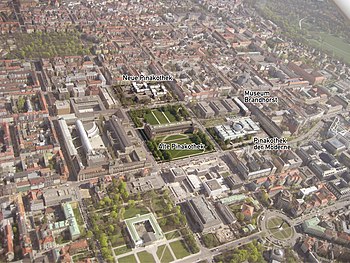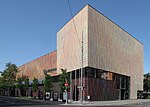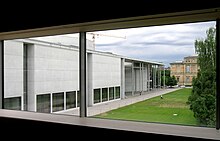Brandhorst Museum
The Brandhorst Museum in art complex in the Maxvorstadt in Munich houses the collection of Udo and Anette Brandhorst modern and contemporary art. The building is located north of the Türkentor and the Pinakothek der Moderne . It was inaugurated on May 18, 2009 with a state ceremony and opened on May 21, 2009. The museum is operated by the Bavarian State Painting Collections . Achim Hochdörfer has been the director of the collection since November 1, 2013 . He is the successor to Armin Second .
building
The Brandhorst Museum is located in the art area on the site of the former Turkish barracks . A building with around 3200 m² of exhibition space and a total of 5300 m² of usable space was created according to plans by the architects Sauerbruch Hutton . The exhibition area extends over three very high floors; Mezzanine floors contain various usable spaces. What is striking is the colorful facade, which is designed in a total of 23 different colors and consists of three different color families. A total of 36,000 square, vertically attached ceramic rods are attached in front of the concrete walls at a slight distance from one another. Depending on the viewing angle and distance, different visual impressions arise for the viewer.
The external facade should not only achieve an attractive appearance, but also make a significant contribution to energy efficiency . The ceramic rods cover a perforated, folded sheet metal that has the task of absorbing the sound of traffic noise. The building itself consists of a two-storey rectangular long building and a significantly higher concrete head building that is widened to the north. The two parts are connected by a continuous ribbon of windows. Behind the glazing on the entrance side there is a spacious foyer with a museum cash desk, bookshop and restaurant. With its entrance on the corner of Türkenstrasse and Theresienstrasse, the museum connects the art area with the busy Maxvorstadt and the lively university district. The building was financed with funds from the Free State of Bavaria (construction costs around 47 million euros). The entire building complex has been planned according to the latest energy efficiency findings. For example, heat pumps, the use of the groundwater in the art area, which is warmed up to 23 degrees Celsius by means of heat exchangers, and component activation (room temperature regulation via floors and walls) should save considerable amounts of energy (and CO 2 ) compared to conventional buildings .
The Bavarian Supreme Audit Office criticized in 2015 that even five years after the opening, numerous construction defects had not yet been remedied. In particular, the expensive technology for controlling daylight is still not working satisfactorily, energy consumption is higher than planned, and the goals of energy saving are not being achieved.
Spaces
The rooms of the museum impress with their size and height and are spread over three levels. The largest halls are on the upper floor, with a size of up to 450 m² and a height of up to 9 m. All walls are white, the floor and staircase are made of solid, light oak (Danish oak). All rooms are different in size and floor plan and are impressive in themselves as interior design works of art. Textile ceilings direct the light evenly into the rooms. Daylight is generally preferred to artificial light . Elements covered with translucent textiles create light ceilings that distribute the diffuse daylight as well as the artificial light hidden above the light ceilings.
The polygonal room on the upper floor was specially designed for Cy Twombly's famous Lepanto cycle in order to be able to present these 12 large-format pictures in a panoramic hanging.
The smaller rooms are on the ground floor. They are connected by staggered passages, so that surprising views of new works of art arise. The classic enfilades are thus avoided. The daylight is brought into the rooms by means of reflectors on the outside of the building through a side skylight.
One has a special view of the Pinakotheken from the lounge of the museum on the upper floor on the north side.
The collection
The Brandhorst Collection comprises a total of over 700 works of art. The collection focuses on works by artists who have had a decisive influence on art since 1945. The Museum Brandhorst mainly shows works by the following artists (selection):
- Cy Twombly : Bacchus ; Summer madness ; Lepanto I ; Untitled (Roses)
- Andy Warhol : Self-Portrait ; Eggs ; Knives ; Marilyn ; Natalie Wood
- Joseph Beuys : Where is my jewelry? Where are my discs, my bridles?
- Damien Hirst : Waste ; In this terrible moment we are victims clinging helplessly to an environment that refuses to acknowledge the soul ; Looking Forward to a Complete Suppression of Pain
- Sigmar Polke : The three lies of painting; Liberté, egalité, fraternity
- John Chamberlain : Lord Suckfist
- Bruce Nauman : 2 Heads on Base # 1 ; Mean clown welcome
- Eric Fischl : Living Room, Scene 3 (Spinning) ; Japanese Bath
An entire floor of the house is dedicated to the works of Twombly, including the work Lepanto , 12 paintings that were created for the Venice Biennale in 2001 and hang symmetrically arranged in a wide semicircle in the Brandhorst Museum. In total, the collection contains over 200 works by Twombly, including paintings, sculptures, graphics and photographs. This is the largest collection of Twombly in Europe. In 2011 the Museum Brandhorst showed Cy Twombly in the exhibition . Photographs 1951–2010 120 photographs from 60 years of the artist's work. In terms of numbers, Andy Warhol is in second place in the collection; the Brandhorsts have acquired over 100 of his works.
From the Brandhorst Collection, the Foundation showed the exhibition Picasso, Artists' Books in 2011 in its own museum and later in the Kupferstichkabinett, Staatliche Kunstsammlungen Dresden .
history
Collection beginnings
The collection has been put together since the 1970s by the Henkel heiress Anette Brandhorst, who died in 1999, and her husband Udo Brandhorst . First they collected classical modernism according to their personal taste before they became part of the Cologne art scene and purposefully acquired works by prominent West German artists such as Gerhard Richter , Sigmar Polke , Georg Baselitz or Joseph Beuys . In line with contemporary tastes, they added Arte Povera and Minimal Art to their collection . The beginnings of the collection from this period show no systematics. In 1993 the collectors transferred their holdings to the Udo and Anette Brandhorst Foundation with the intention of making them publicly accessible. It was then that they began to focus on specific acquisitions. The center was American contemporary art from the 1960s to 1990s, with a focus on Cy Twombly and Andy Warhol .
Foundation of the museum
Around the year 2000, after the death of Anette Brandhorst, Udo Brandhorst began looking for partners to found a museum. He stipulated that the collection had to be shown as an independent museum and looked for a city or state to finance this. The Brandhorst collection was sharply criticized by the specialist public. It would not achieve the necessary museum rank, individual pieces would be of outstanding quality, but that does not justify an independent museum. The demand for a museum to be built by the public sector would be a sign of the collector's megalomania and a sign of a complete overestimation in the art world.
Agreement with the Free State of Bavaria
After several years of debate, the Free State of Bavaria was ready to meet Brandhorst's conditions. Until then, the Brandhorst family had no special relationships with Bavaria or Munich.
The agreement between the collector and the Free State of Bavaria stipulates that the public sector should build the museum and assume operating and personnel costs. In addition to the works of art, Brandhorst is contributing endowment capital of 120 million euros to the Udo and Anette Brandhorst Foundation , from which 2 million euros are available annually for purchases. The director of the museum is the respective director of the foundation, he decides independently about the pictures to be shown and purchases. The Free State sits on the Board of Trustees through the Bayerische Staatsgemäldesammlungen , but holds a minority position there.
criticism
When the museum building, which was built for around 47 million euros, was opened in 2009, criticism of the collection was raised again. The collection was brought together as desired, apart from Twombly there was no focus that was not already available in the Pinakothek der Moderne. On the contrary, many of the works in the Brandhorst Collection would definitely fit in with the Pinakothek's holdings and could complement the exhibition there, but the establishment of a separate museum for the Brandhorst Collection would make this overview impossible. The role of the collector was again sharply criticized, he was accused of vanity. The criticism was directed even more at the Bavarian state government: It would have been dazzled by the names of the artists represented in the collection and the amount of the foundation's contributions. It would have left the sovereignty to the private foundation and the founder, who now shows himself to be a man without qualities and the collection without any recognizable signature.
Exhibitions
- 2016: Painting 2.0. Painting in the Information Age ; then Museum of Modern Art Ludwig Foundation Vienna . Catalog.
Placement program
The educational program is carried out by the visitor service and art education of the Pinakotheken as well as by the Munich Adult Education Center.
literature
- Bavarian State Painting Collections: Museum Brandhorst - The Architecture. Hatje Cantz Verlag, 2008, ISBN 978-3-7757-2354-1 , (with texts by Armin Zwei, Andres Lepik , Andreas Burmester).
- Bavarian State Painting Collections: Museum Brandhorst: Selected Works. Painting, sculpture, graphics, photography, new media. Prestel Verlag, 2009, ISBN 978-3-7913-6235-9 , (with texts by Carla Schulz-Hoffmann , Armin Second, Barbara Catoir).
- Picasso, artist books. Works from the Udo and Anette Brandhorst collection. Hirmer, Munich 2010, ISBN 978-3-7774-3101-7 .
Web links
- Website of the Brandhorst Museum
- Munich art area
- Udo Brandhorst ( Memento from December 18, 2010 in the Internet Archive )
- Supreme Bavarian. Building authority: brief description of the construction project ( memento of August 5, 2008 in the Internet Archive )
- Telling history pictures: to Cy Twombly's Lepanto
- Sandra Hofmeister: Colorful chopsticks and Cy Twombly. Reviewed May 27, 2009 with pictures of the building and the first hanging.
Individual evidence
- ↑ New boss wants to rejuvenate Museum Brandhorst . In: The world . November 19, 2013. Retrieved December 5, 2013.
- ↑ a b c Hanno Rauterberg: A monument of selfishness. In: The time. May 21, 2009, accessed March 7, 2015 .
- ↑ ORH report 2015: New building of the Brandhorst Museum , accessed on March 31, 2015.
- ^ Anna Rühl: The Brandhorst Museum. CH Beck 2013, ISBN 978-3-406-63139-9 , p. 11.
- ^ Anna Rühl: The Brandhorst Museum. CH Beck 2013, ISBN 978-3-406-63139-9 , p. 59.
- ↑ When pictures speak volumes. In: FAZ of January 17, 2011.
Coordinates: 48 ° 8 ′ 53 " N , 11 ° 34 ′ 27.2" E








